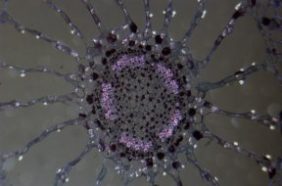Earth’s early oxygen boost
The steady buildup of oxygen in Earth's atmosphere may have helped life forms become more complex.
Share this:
- Share via email (Opens in new window) Email
- Click to share on Facebook (Opens in new window) Facebook
- Click to share on X (Opens in new window) X
- Click to share on Pinterest (Opens in new window) Pinterest
- Click to share on Reddit (Opens in new window) Reddit
- Share to Google Classroom (Opens in new window) Google Classroom
- Click to print (Opens in new window) Print
Early in Earth’s history, our planet was home to only simple creatures—little organisms made up of just one sort of cell. Today, plants and animals can have more than 100 cell types.
How did life forms get so complicated? Scientists at Pennsylvania State University may now have part of the answer. The secret ingredient could be the oxygen in Earth’s atmosphere.
 |
|
Example of a plant cell, stained and viewed under a microscope.
|
The researchers found a relationship between the number of cell types in organisms and the quantity of oxygen in Earth’s atmosphere. The more oxygen there was, the more complex the organisms could become.
Early in Earth’s history, there was very little oxygen in the atmosphere. Only simple, single-celled organisms such as bacteria were around. Then, about halfway through Earth’s history (2.3 billion years ago), oxygen began to accumulate in the planet’s atmosphere. Around the same time, organisms with several types of cells appeared.
Researcher S. Blair Hedges says this happened because of an important change in the structure of cells. Some cells developed features called “mitochondria.” These are the little power plants inside cells. They use oxygen to generate energy.
Mitochondria were essential for organisms to become more complex. “It makes a lot of sense,” Hedges says, “because to have complex organisms, you need energy.”
Later, about 1.5 billion years ago, there was another change in cells that enabled organisms to become even more complex. Some cells developed features known as plastids. These are the parts of cells that enable plants to produce oxygen through photosynthesis.
The plastids boosted the amount of oxygen in Earth’s atmosphere. With more oxygen available, mitochondria could generate more energy.
Hedges and his colleagues estimate that organisms with up to 10 cell types emerged with the help of plastids. And the numbers kept growing. By 1 billion years ago, organisms with up to 50 cell types had appeared, the researches say.
Fossils had suggested that a big jump in the complexity of organisms took place 600 million years ago. If the estimates by Hedges and his colleagues are correct, life actually started on the road to complexity a lot earlier.
Going Deeper:
Travis, John. 2004. Gassing up: Oxygen’s rise may have promoted complex life. Science News 165(Feb. 7):85. Available at http://www.sciencenews.org/20040207/fob5.asp .
You can learn more about animal and plant cells at www.enchantedlearning.com/subjects/plants/cell/ (Enchanted Learning) and www.cellsalive.com/toc.htm (Cells Alive!).







